Make Old-Fashioned Brine Fermented Pickles Like Your Great Grandmother
I’m standing at the kitchen counter of the cabin my husband built for us when we moved off-grid. It’s over 90 degrees, it’s approaching the lunch hour, and my three children, aged 1 – 6, are getting hungry.
A set of red headed pigtails is at my side while I chop the mid-summer vegetables that need preserving – summer squash, cucumber, and a few green tomatoes that came off the vines too early. They’re all going into a gallon jar of pickles that will contain no vinegar, will never be heated or boiled, and will not see a lick of refrigeration.
These are old-fashioned brined lacto-fermented pickles. It’s a mouthful, in more ways than one, but these are the pickles our great grandmothers made. They keep for months, if prepared properly, I really appreciate the health benefits we enjoy from them, and though I’ve made them for years, I appreciate them even more now that we’re taking a crack at this sustainable off-grid homesteading life.
Oh and they are dead easy to make.
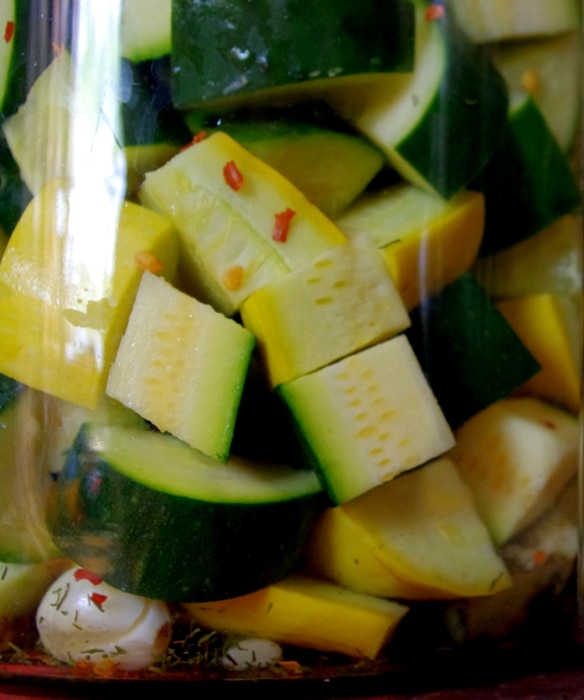
The process of lactic acid fermentation is part art and part science. You’re probably familiar with sauerkraut and kimchi. By the same biological process we can make brine-pickled vegetables from literally whatever is in the garden.
The same beneficial organisms we find in good soil are on the surface of the vegetables we pick. Those beneficial organisms feast on the carbohydrates in the vegetables and produce organic acids as well as enzymes and beneficial bacteria.
It is the acids produced – part lactic and part acetic – that form the brine that preserves the vegetables from spoilage.
This process must happen anaerobically, outside of the presence of oxygen, which is why the vegetables are covered in a salt brine. This is the most critical aspect of the fermentation process: you must keep your vegetables covered in brine.
Beyond that, the process is unbelievably easy.
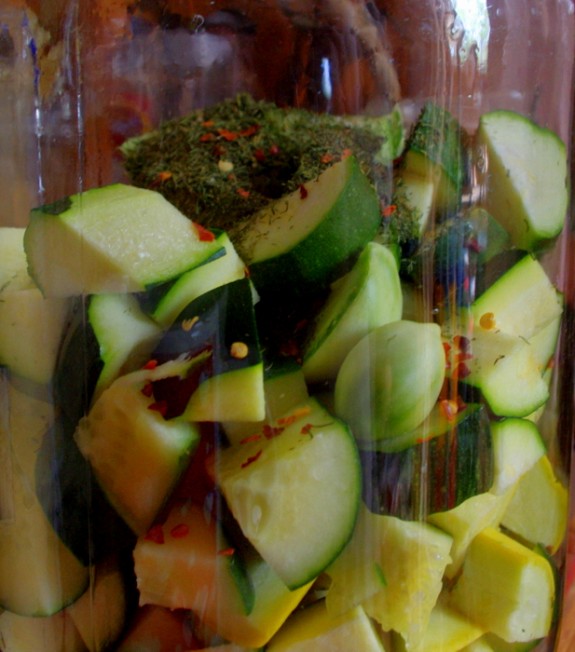
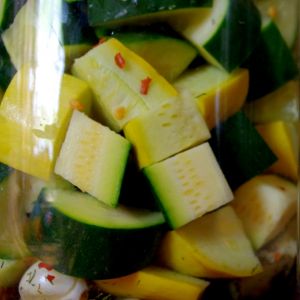
Make Old-Fashioned Brine Fermented Pickles Like Your Great Grandmother
Ingredients
- Salt for brine
- Seasonal garden vegetables
- pickling spices
- leaves for crispness
Instructions
- Prepare a brine using the ratio of two tablespoons of salt to one quart of water. If it is over 85 degrees in your kitchen, use one extra tablespoon of salt. Stir well and set aside.
- Chop vegetables into sticks or bite-sized pieces.
- Gather flavorings – garlic, onions, fresh herbs, or your favorite pickling spices.
- Add garlic, herbs, and spices to the bottom of your clean quart, half-gallon, or gallon jar.
- Add one of the following to keep your vegetables crisp: grape, horseradish, oak, black tea (yes the kind you drink), or mesquite leaves. Read more on why at the Cultures for health blog.
- Place chopped vegetables atop flavorings, leaving at least 2 inches of headspace from the rim of the jar. Pour the brine over the vegetables so they are covered by at least one inch. Two to four inches is even better, but hard to achieve in quart jars.
- Weight down your vegetables so they stay below the brine while fermenting. I have used small plates that will fit into the jar opening, inverted plastic jar lids, a large cabbage leaf, root vegetable slices, or glass weights made specifically for this purpose.
- Cap the jar tightly and allow to sit at 65-85 degrees for around 10 days, or more, depending on your preference. The longer they ferment at room temperature, the sourer they become. Read more on how to tell when they are done.
- During the earliest stages of fermentation carbon dioxide is released. Check your jars once or twice a day to see if the lids are building up pressure. If you cannot press down on the canning lid as you normally would, very quickly and carefully “burp” your jar by slightly unscrewing the lid, allowing a bit of gas to escape, and screwing it back on quickly.
- Once completed, move to cold storage – a root cellar, a basement, a cool garage, anywhere below 65 degrees, or yes – a refrigerator.
Looking at that list of 10 to-dos can be intimidating, but I promise you that once you do this a few times and understand the process, it is the easiest way of making pickles with whatever produce you have and in whatever size batches you need.
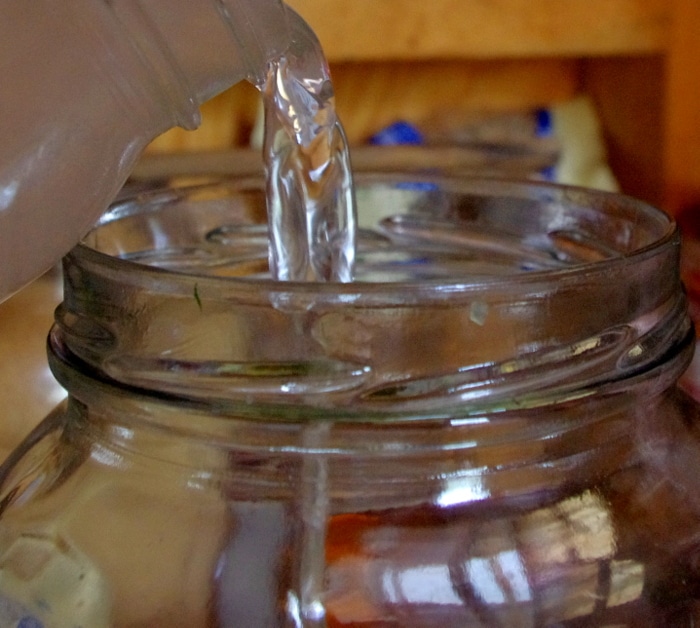
If you’re interested in more specific recipes to get started with, here are a few of my favorites:
- Lacto-Fermented Kosher Dill Pickles
- Lacto-Fermented Summer Squash
- Lacto-Fermented Southwestern Carrot Sticks
Have you tried making pickles without turning on the canner?

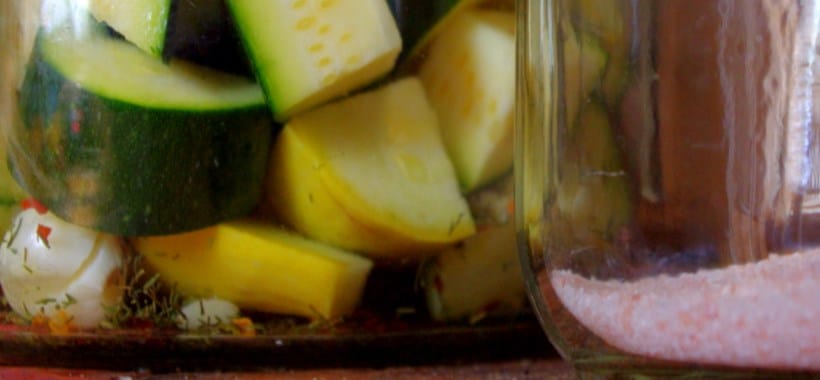
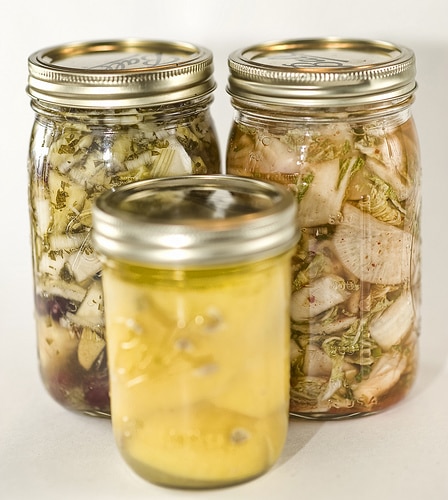
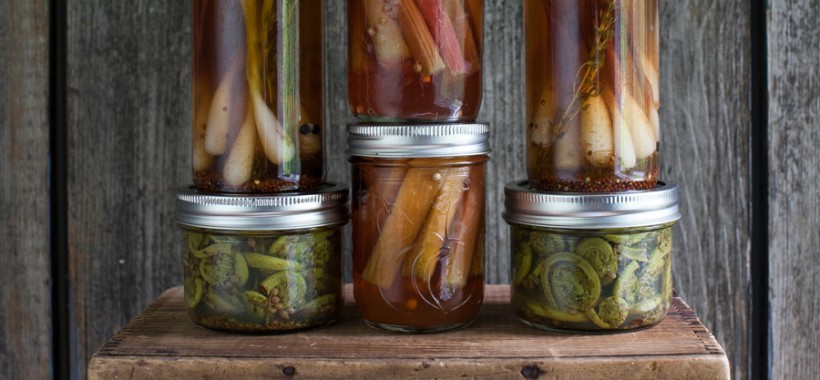
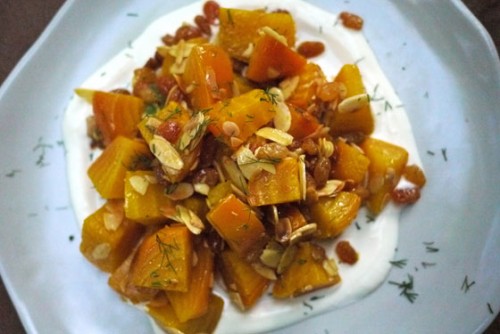
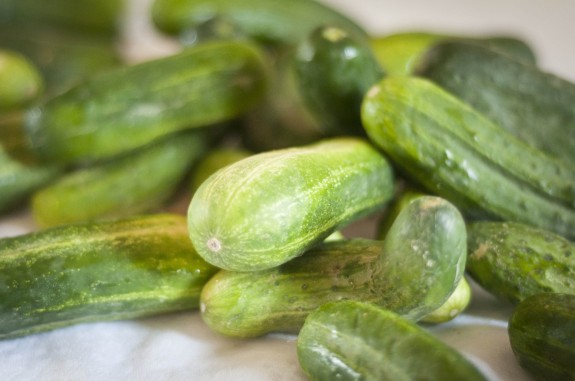
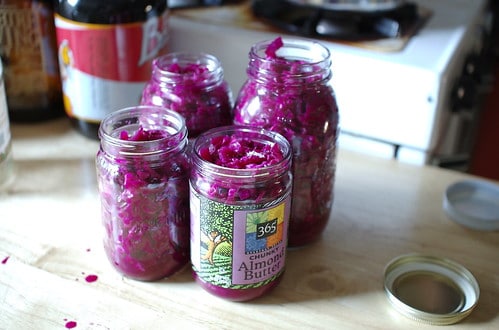
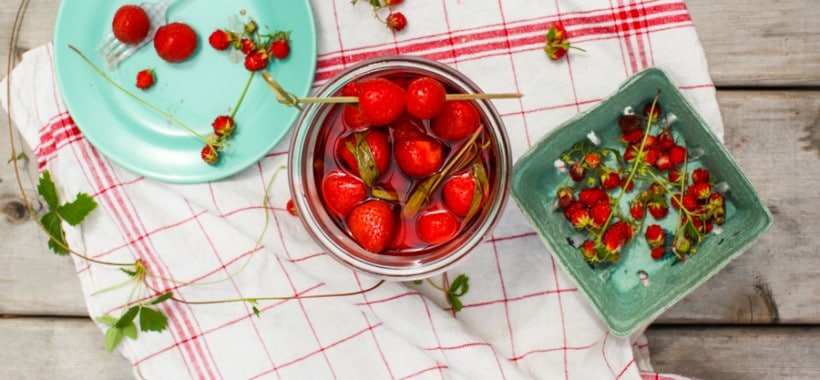
Great pickling recipe, thanks! 🙂
I’ve been playing around with lacto-fermented pickles ever since I read Michael Pollan’s book Cooked in the spring. So far, I’ve gotten my recipes from health blogs, not from food blogs. I’m so happy to see this here!
And thanks for the tip about how to keep the pickles crisp. I needed that. 🙂
Anne – Glad to help! There’s nothing more disappointing than a mushy pickle is there?
The grape to keep crisp you mean fresh grapes & how many.
No GRAPE LEAF NOT GRAPES
Just any grap leaves from a grape vine?
Grape leaves and as many as it takes to cover your pickles
Thanks for this recipe! I’m also interested to learn how to make pickled jellyfish. 🙂
How long do they make it when in cold storage? We have a bumper crop of cukes, but not sure we could do this……but it sounds better than canning!
To be honest, this depends upon a lot of things. If all variables are ideal, then you could keep them for months. This is how folks used to get through the winter. When we had a refrigerator, I stored them for 6-7 months. You can see a post I did, with photos, detailing how well they keep: http://www.nourishingdays.com/2012/05/what-my-7-month-old-fermented-vegetables-look-like-and-why-im-a-fan/
I keep mine in the refrigerator for use within a year but they can be kept in a cool place for nearly that long. They don’t go bad (if prepared right) but just get mushy and have an off-taste. I found some pickles in the back of my pantry from four years ago. Still tasted okay but were soft.
This sounds AMAZING! I can’t wait to try this – I’ve made quick pickles just by tossing fresh veg into a vat o’vinegar and such, but I need more lacto-fermented food in my life. I’m going to do this with my next batch of farm market cukes!
Amber – Great! I hope you enjoy them.
How do you know when they are ready to eat?
Auntiepatch – Oh dear, it appears I forgot to add the hyperlink. You can find a more detailed article I wrote on when to know if they are ready for cold storage here: http://www.culturesforhealth.com/how-to-know-fermented-vegetables-ready-cold-storage/?a_aid=512d2cbc1d339
One thing I might amend is that bubbles indicate fermentation is happening, not necessarily that it is complete. Most people are finding that a longer, lower temperature fermentation results in a much tastier pickle. So, the bubbling may be complete, since it is a product of the earlier stages of fermentation, when you are ready to move it to cold storage.
I fish one out of the crock and taste it. Half-sours can be ready after three days. The longer they are in, the more “pickled” they become. When they taste the way you want them to, they’re ready. NOTE: half-sours (like in a Jewish deli) need to be eaten within a few days for them to remain white and crispy. In the refrigerator, they will continue to “cook” until they reach regular sour or dill-pickle stage.
Perfect on any sandwich, thanks for a nice recipe.
Shannon, thank you for sharing information with us. I do have a question: As you are off-grid, how do you store the fermented veggies after they are “done”? I am in a tiny apartment, with a tinier refrigerator (thus, no cold storage options), and have hedged at trying recipes because I really don’t know the answer to this question.
Thanks!
Ouida – Refrigeration is not necessary for storing fermented vegetables. We are still in the process of building our root cellar attached to our home. Once that is complete that is where we will store them.
We live in the south, so during the summer my only option is a cooler sunk into the ground, at least 4-6 feet. It acts as a many root cellar. In the winter, or perhaps in a cooler climate for most of the year, you could store it in a cool part of your home. Ideally the temperature would be below 70 degrees, 50-65 being ideal.
If you have a cooler part of your home that fits those requirements, perhaps you could try a small batch, see how it fairs, and then expand from there.
This fermentation process is how the Koreans make Kimchee and they used to bury their crocks in the ground for fermentation and probably for preservation.
Hey Shannon,
Great recipe!!
Thank you for sharing your passion on this topic.
Regarding storage I found a link that describes how to can them after fermentation.
I hope it’s okay to post…
http://edis.ifas.ufl.edu/m/#publication?id
I have not tried it yet.
Brian
Ah, you’ve cleared something up for me! I’d tried doing the lacto-fermented pickles from “Nourishing Traditions” using whey, and my pickles looked and smelled nasty. (I wasn’t about to try them, they were that awful.) I’d read so many good things about lacto-fermentation that I didn’t want to skip the whey, but y0u’ve helped me realize that the brine will still make lactic acid even without it. Thank you!
Off to make some pickled carrots and onions now. Thank you so much!
Katie B – I know exactly what you’re talking about. I started making veg ferments with whey, according to NT, also. Once I switched to just salt they got so much better.
I have found that there are several problems with the directions as outlined in NT, so don’t generally stick with those exact recipes, though the ingredients in the salsa and cortido recipes are a good start.
Could I use old jars & lids from a previous jar of store bought pickles, salsa, olives, etc.? Or is having that separate rubber ring (mason style jar) necessary to doing this safely?
Actually, the lid really doesn’t matter. Many old-timers made pickles and sauerkraut in large crocks with nothing more than a weighted plate over the vegetables and brine.
The most important thing, to keep your pickles well-preserved, is to keep the vegetables below the level of the brine.
Thanks for sharing this recipe! In one of my jars, the top couple of cucumbers keep floating up out of the top of the brine. I check on them each day and poke them down, then add a little more brine. It’s been two days since I made them; today I took a couple out in hopes that they would all stay down.
Will two days of floating cause the pickles to spoil? Will all the pieces be affected, or just the ones that floated up?
When I brined whole cukes, they also floated to the top. I found out that if you make a slit in the cucumber before brining, they are less likely to pop above the brine. They are still okay to eat unless mold forms on them.
I did not have time to sift through the comments, so you may have already answered this. But you implied a link for learning tips on how to tell if they are done – but there was no link on the “here.” Could you recommend? Thanks!
So I’m at day 6 of fermentation, and I’ve been releasing the pressure in the jar as needed. But this morning when I did that, it blew like a shaken pop can. I lost about a quarter of my brine. I guess I didn’t expect it to become dramatically more effervescent with time. It’s also getting cloudy, with a white film on the bottom.
I have a question here. I followed your directions except I also put a few green beans (raw) on the jars, now someone told me I can’t do that because “canned raw beans are toxic” and I could die from eating it. Is it true? If so, Can I still save the cucumbers at least?
Maybe this person was referring to kidney beans which are toxic if not cooked at high temperature for the appropriate amount of time.
Canned green beans need to be pressure cooked to avoid botchulism….
I just started playing with lacto-fermentation this summer, and am very excited about my sauerkraut and pickled veggies. However, my pickled veg turned out *extremely* salty, and I’m wondering two things: 1. Do they just need to ferment longer (I think they’ve been going about a week now) and 2. can I add fresh veg to the jar, or will that throw off the balance? Thanks! (I didn’t use this exact recipe, but I think it was basically the same).
Hey Shannon, I just wanted to let you know that a) I linked to this yummy old-timey pickle post in a recent blog that I did – http://www.bhfood.org.uk/blogs/10-ways-to-save-an-apple – which was about apples, but really about ways to make food last for ages, and I hope that’s alright with you; and also b) that I just acquired 12 massive cucumbers from a local growing project and will embark on this pickling adventure tonight, along with a pit stop in cucumber-kimchi-ville. As an aside I also wanted to thank you because, as a Russian I personally insist on the superiority of salt brine pickles over vinegar pickles, and am glad you outlined their awesomeness so well.
I found my grandmothers old recipe for what she called Salt Pickles. I remembered we loved them. I’m assuming they are fermented but the recipe only has ingredients. This is her recipe: 8 quarts water, 1 lb. rock salt. Boil water and salt and keep hot to fill jars. To each quart of cucumbers, add dill, 1 clove garlic, 4-5 whole black peppercorns and 4-5 pieces of bell pepper. That’s it. Do you think I just follow your fermenting technique? I see she did not add the leaves or mention weighting them down. She died 13 years ago at age 90. Your thoughts?
The addition of vinegar lets you know this isn’t a brine recipe. This is most likely a recipe for canned pickles (once you finish the recipe as you’ve posted it, then you hot water process the pickles in canning jars). Make some and let us know!
I used your recipe for brine, and your general ideas for my first attempt at lactofermentation today. Keep your fingers crossed. I found some frozen horseradish leaves in this little ethnic grocery store called Andy’s Fruit Ranch, here in Chicago. No where could I find fresh grape leaves. Can you use jarred grape leaves? I have a polish crock with a water trough that will self burp without bacteria and mold getting in.
I use old fashioned Pickling lime to soak my cukes before brining, then for extra insurance, add an 1/8 teaspoon of Ball’s Pickle crisp to each pint jar. These are calcium products and not harmful to health in any way. My grandmother used to get her calcium chloride from somewhere to crisp her pickles.
I am using a salt brine recipe for pickles
and using a crock, it is day 5 of 12 and there is mold on top of the brine. What did I do wrong?
if the mold you are referring to looks like tiny white balls, then there is NO PROBLEM. Just scoop out as much as you can and don’t be concerned about any you miss. It won’t ruin anything. Its kamfir yeast and its not harmful, toxic or anything to be concerned about. Its pretty normal.
Hi,
Just wanna thank you for the recipe, I am making 2nd batch today with homegrown cucumber. One and the only Japanese cucumber (Kyuri) I planted is very productive, 6-7 cucumbers a week!
Can you can these after the fermentation process?
I was delighted to google “fermented pickles” and come across this post by one of my favorite bloggers! I have been slowly being academically convinced of the safety and health benefits of fermented foods but after trying Nourishing Traditions whey-based carrots last year and disliking the taste, haven’t returned to try fermenting anything else (I should note that they are incredibly preserved STILL, a beautiful orange color even after at least a year of storage, though we won’t eat them now, they’re just tucked in the back of the refrigerator to remind me that I really should try my hand at another recipe). I was pleased to see these just use a salt brine for the fermentation and now have four quarts of cucumbers, spices and grape leaves sitting on my kitchen table. They were quick and easy, done in an hour while my husband had the children on an errand and no hot canner running to boot and hopefully no refrigerator space necessary. Thank you for sharing the details and the links. I can’t share whether they’ve turned out, of course, having just made them, but I am eagerly awaiting the first taste to see how they come out and whether I will be converted for good! 🙂
I was wondering if after you refrigerate them do they need to still be submerged in the brine? I tried one to see if they were good to refrigerate and some cucumbers started to float after I pulled one out. Do I need to put a weight inside or should they be okay since they are refrigerated? Also the brine level went down so do I need to add more water or brine as I pull pickle out?
When making salt brine pickles ( like Bubbies pickles ) is it OK to use a 6.5 gallon food grade plastic container to ferment in ??? Or does it have to be glass or ceramic ??
Thanks,
Richard
Richard,
You can use the larger food grade containers – in fact, you can get one of these airlocks for a big container (or you can even use one of these with a smaller container) and it prevents you from having to “burp” the container: http://www.bit.ly/airlocks. These are often used in brewing for the fermentation cycle but they emulate the type of fermentation pots they use in Europe that have water-filled rims.
Hi, I am new to pickling, do you need to sterilize your jars in boiling water first before you fill them
thanks, Tom
In the recipe you mentioned ‘salt for brine’ and I was wondering what type of salt this is. I have coarse sea salt and non-iodized table salt. Would any of those be ok? In the same quantities as in your recipe? Thanks!
I found your instructions AFTER I already added vinegar 🙁 I had already put in half vinegar/half water as well as the other spices to a gallon of green tomatoes. What should I do now?
hi there,
thanks for sharing, i really look fw to try this and all the goodness of fermented veg!
but i’m really new to this and have a few questions. when you mention black tea for crispiness, how do you mean it? as in a tea bag inside with the brine? or do i prepare a tea cup and then add it to the stuff? and for the time the jar has to sit around at room temp, can it get light? or should it stay in the dark? i’m pretty sure i remember a friend from iran doing a batch and placing them in the sun… wonder if that’s ok… because i’ve been playing with kefir for about 10 days now and that needs darkness.
anyways thanks again!
best x
I made the salt brine poured it over the green tomatoes yesterday with grape leaves and garlic and dill but no reaction yet today.No burping or any bubles.Are they coming much later or did I do something wrong?Kruna
Hi Shannon,
We live in Arizona and our property has tons of mesquite. I have heard about using grape leaves for crispiness but never mesquite. The leaves are very small. Do we just add a good amount to the mix?
Thanks for the advice,
Mike
I would like to know this as well. I have been trying to research the safety of consuming mesquite leaves (those commonly found in Arizona). I make fermented pickles all the time using grape leaves. They are hard to find but I have a mesquite tree in my front yard.
Make pickles like my great grandmother?! How did you know my great grandmother was a pickle?!
Hi Shannon,
I was wondering if you had to use canning jars of if you could just reuse jars from other products like spaghetti sauce, salsa, etc.
I you’re not canning them in a waterbath or pressure canner, use whatever jars yo have that seal well.
Thanks for this easy recipe. I have searched high and low for this. Just tried my hand at this last night for the first time. Wish me luck.
Do the jars of pickles need to be processed ?
If you’re posting a “recipe” you should probably put what spices to use, not just “pickling spices”. I’m trying to make home style cucumbers in brine, and looking for new recipes, and this doesn’t even tell you how much to put of anything, let alone WHAT to put in it.
Karol – If you’re posting a “comment”, you should probably use your brain first. Pickling spice is sold as PICKLING SPICE, just as it’s stated in the recipe above. Use common sense. You buy it in the store like that.
You can say the same thing without being critical. It helps no one, and creates feelings no one wants to have.
Just FYI, I cut the lid of a yogurt container to use to push the cucumbers under the brine, and then weighed that down with a small cup.
I just wanted to thank you for this page, and recipe. When I was a young boy, my mother made what she called Salty Brines. The best pickle I’d ever eaten. To this day I’ve not found a commercial product that equals her pickles and I’ve been too gun shy to try them on my own.
I did find a brand imported from Poland that kind of reminded me of them, but they are expensive and I have to drive 25 miles to buy them. Which I have been doing now n then for the past few years.
Well not anymore. I decided to try my hand at making them and have read many articles about the process. I decided to use your 2tbs salt / quart of water brine mixture and asked my sister if she remembered what spices our mother used.
So last week after picking a good crop of cucumbers from my garden I put up three test jars.
I burped them today, and I’m beyond happy. The smell that rose up from the jars when I loosened the lids immediately took me back to the days of my youth. My hard working country mother standing at the table making pickles and jams from the fruits and veggies freshly picked from our huge garden.
It was moving, and I’m not ashamed to say I teared up. It’s wonderful how a simple thing like the smell of a long lost recipe can suddenly bring on such vivid memories and stirring emotions.
Thank you for sharing your recipe. It helped me reconnect with a dearly missed loved one. I look forward to showing my 9yo son how to make these and sharing good memories with him.
Not all salt has the same size crystals, so it might be good to weigh your salt. Sea salt or kosher salt has larger crystals than table salt (don’t use iodized). You can find tables on the internet that tell how many grams or ounces of salt to volume of water produce the correct brine. 5% is recommended for pickles.
This process is so easy and very tasty also. You can add spices to please your palate. If it tastes too salty, it’s not fermented enough.
To weigh down the pickles you can use a ziplock bag with some brine, a bag of marbles or a narrower jar. I recently got an airlock which makes the process a little tidier.
I did this with green cherry tomatoes 5 days ago. I was looking at the jars and one of them had mildew on the grape leaves I had put on top. I took them out of the jar but now I’m wondering if the jar is ruined or if I can still let iy continue to ferment? Please advise me.
Thank you 🙂
Well, it hit all of the jars now. I’m wondering if it was because of the grape leaves since they were starting to turn. Oh well, maybe I will try again using black tea leaves instead if the grape leaves.
Try Ball’s Pickle Crisp. Available at Walmart, Amazon, and other places that carry canning and pickling supplies. Works like magic!
I also soak m cukes in pickling lime for a couple of hours before slicing and brining. Follow the instructions carefully and rinse really well or the brine will turn cloudy.
Don’t know if this has been suggested, but my awesome favorite pickling vegetable: okra!
is the ratio of 2 table spoons of salt for 1 quart of water for meats as well?
No, you cannot lactoferment meat like this. This recipe is for plants only. If you want to salt meat to preserve it you need WAY more salt and a different method.
When you speak of putting grape in to help with crispness….. are you referring to grapes… like the red grapes I get in the fruit section? I really really new at this and it’s probably a goofy question.. but I need to know. Please help. : )
Thanks so much
Dinah
I understand the jar has to be burped once or twice a day to avoid cracking or exploding the jar, but when people say they can be stored for months… does that mean I have to burp the jars everyday for months to come?
I am 86 years old. I was making brined pickles probably before any of you were born. They would keep forever in quart jars. I used whole cucumbers though and stood them up in the jars. Added some fresh dill and garlic cloves. You could also add spicy little red peppers if you like spicy. I stood the jars in a very large galvanized washtub because as they fermented they would boil out some juice. They kept beautifully and my family loved them. This was back in the 1950’s when I was young and able.
Barbara I would love to pick your brain for some of your pickle knowledge. I made for the first time last year and they were great unfortunately the ones I made this year were not good and became garbage. My email is [email protected]
I used to make salt brined pickles like these years ago. I’d keep them on the counter away from the window with the jars on towels to catch the bubble over of the brine. I haven’t made in a long time but now that I’m retired I’m going to make a batch tomorrow.
Fantastic tip with the black tea. I am just about to set about doing my first ever batch in distilled water and sea salt. Will definitely add a pinch to ensure that extra crispness. Thanks
this is my first ferment and since i dont have any equipment i used the normal mason jar now after 1 week the cabbage leaf that I used on top has got a white mold,should I rinse it and use it again to submerge the veggies, or should I discard it, also the brine has got droplets of mold so should scoop up this and thow it away and add some more brine please advise.. Thanks
I’m hoping you can answer a question (actually 2 questions): Regarding pickles cucumbers, does using lower salt brine such as 3% vs 5% and aging longer at higher salt brine make a difference to final outcome? For example, using 3% and fermenting 2 weeks vs using 5% and fermenting 4 weeks end up with the same result or different result? The second question, kind or related: fermentation done once the CO2 bubbles stop rising? Is there any benefit to aging in brine longer than that or is it done changing once the fermentation has stopped?